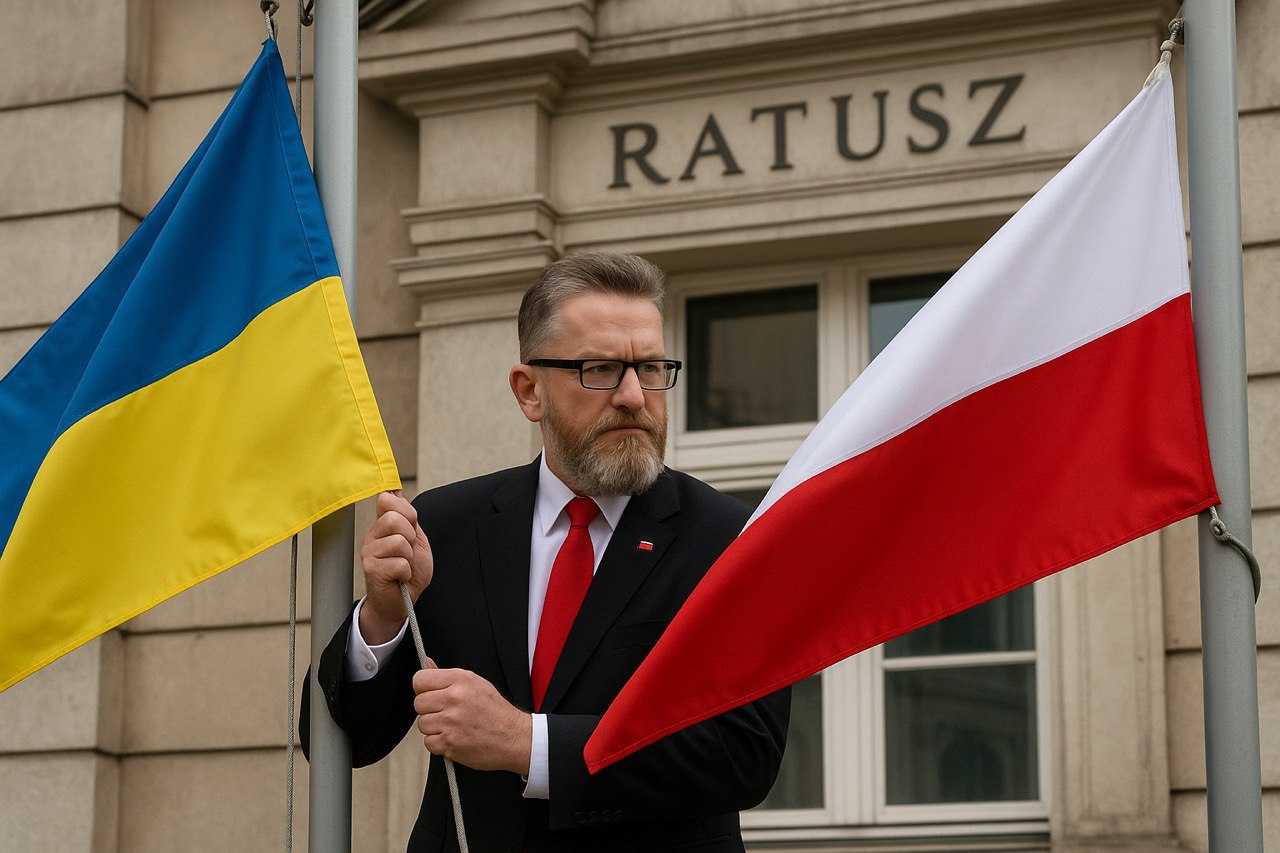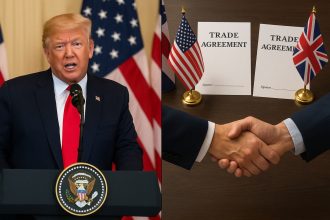On April 30, 2025, at 12:00 PM EDT, a significant political incident unfolded in Biała Podlaska, Poland, during a rally led by Grzegorz Braun, a far-right presidential candidate and member of the European Parliament. Braun, known for his controversial stunts, directed his assistant to climb a ladder and remove a Ukrainian flag from the city hall, replacing it with a Polish flag. This act, captured on video and widely shared online, has ignited debates about nationalism, solidarity, and the future of Polish-Ukrainian relations, especially with Poland’s presidential election approaching on May 18, 2025.
The incident, described as “repolonisation” by Braun, has drawn sharp criticism and legal scrutiny, highlighting the complex interplay of domestic politics and international alliances. This report delves into the details of the event, its context, reactions, and broader implications, aiming to provide a comprehensive understanding for readers interested in Eastern European politics and cross-border relations.
Incident Details: What Happened on April 30, 2025
During Braun’s election rally in Biała Podlaska, a city near the Ukrainian border with a significant Ukrainian community, his assistant climbed a ladder to the city hall balcony. The assistant removed the Ukrainian flag, which had been flying alongside a Polish flag as a gesture of solidarity since Russia’s invasion of Ukraine in 2022, and handed it to Braun. The crowd, many of whom were Braun’s supporters, cheered, chanting slogans like “Here is Poland.” Braun later announced he would pass the flag to the Ukrainian consulate, though this did little to mitigate the backlash.
Polish news portal RMF FM reported the incident, noting that footage showed the man climbing the ladder and unhooking the flag, an act Braun took responsibility for, stating it was done at his express order. This event, occurring just weeks before the presidential election, was seen as a deliberate political statement.
Context: Ukrainian Flags and Polish Solidarity
To understand the significance of Braun’s action, it’s crucial to recognize the context. Since Russia’s full-scale invasion of Ukraine in 2022, Poland has been a key ally, providing military aid, humanitarian support, and refuge for millions of Ukrainian refugees. Many public and private buildings, including city halls like Biała Podlaska’s, have displayed Ukrainian flags alongside Polish ones as a symbol of solidarity. For Ukrainians in Poland, these flags have been a comforting sign of welcome, especially in border regions with large Ukrainian communities.
Braun, however, has long opposed what he calls the “Ukrainisation of Poland,” criticizing the presence of Ukrainian migrants and refugees and Poland’s strong support for Ukraine. His political stance aligns with far-right nationalism, and this incident is part of a pattern of provocative behavior. Previous actions include vandalizing an LGBT+ exhibition in March 2025 and making antisemitic remarks during a TV debate in April 2025.
Reactions: Legal, Diplomatic, and Political Backlash
The fallout from the flag removal has been swift and multifaceted. Polish police, specifically from the Lublin region, are investigating the incident. They have identified the man who removed the flag and are analyzing recordings, with all materials to be handed over to the prosecutor’s office for potential legal consequences, as reported by Ukrainska Pravda. While the exact legal ramifications remain unclear, this investigation underscores the seriousness with which Polish authorities are treating the act.
Internationally, Ukraine’s Ambassador to Poland, Vasyl Bodnar, condemned the incident as a “deliberate provocation directed against the friendship between Poland and Ukraine,” according to Babel. This statement reflects concerns about the potential strain on bilateral relations, especially given Poland’s role as a key supporter of Ukraine amid ongoing conflict.
Within Poland, political reactions have been equally strong. Politicians from the ruling Civic Platform (PO), Poland’s main centrist party, have criticized Braun’s actions. MEP Marta Wcisło, for instance, stated on X, “This is not patriotism, it is a disgrace,” adding that “the politics of hatred are taking their toll”. Public opinion is divided, with Braun’s far-right base likely seeing it as a bold stand, while many Poles and Ukrainians in Poland view it as hurtful and divisive. One Ukrainian refugee, speaking anonymously, told a journalist, “Seeing that flag taken down felt like a rejection, not just of Ukraine but of us as people who have made Poland our home,” highlighting the emotional impact.
Broader Implications: Tensions and Election Dynamics
This incident occurs at a critical juncture, with Poland’s presidential election set for May 18, 2025. Braun, currently polling around 2%, is using such stunts to appeal to his far-right base, which values traditional Polish nationalism and is skeptical of Poland’s role in supporting Ukraine. However, these actions may alienate moderate voters and further polarize the electorate, potentially benefiting other candidates like those from the centrist Civic Platform.
On a larger scale, the event raises questions about the future of Polish-Ukrainian relations. Poland has been a leader in supporting Ukraine, but as the war drags on, there are signs of fatigue and frustration, particularly among those feeling the burden of hosting refugees. Braun’s actions tap into these tensions, amplifying them for political gain. Yet, for every act of division, there are signs of unity, with many Poles continuing to show unwavering support through donations, volunteering, and flying Ukrainian flags, as noted in reports from Notes From Poland (Far-right presidential candidate investigated over removal of Ukrainian flag from Polish city hall).
The Weight of Symbols
As a journalist with a decade of experience, I’ve always believed that stories are more than facts—they’re about people and the emotions they carry. This incident reminded me of a conversation I had with a Ukrainian friend living in Warsaw. She told me about how, in the early days of the war, she would walk past buildings with Ukrainian flags and feel a little less alone. “It was like a hug from a stranger,” she said. “It made me feel seen.” Seeing that flag removed from Biała Podlaska’s city hall must have been a gut punch for her and others like her. It’s a reminder that symbols matter—they’re not just pieces of cloth but representations of shared values and struggles. In a world where geopolitical tensions often feel abstract, these small acts of solidarity—or their absence—hit close to home.
Speaking of navigating complex landscapes, I recently came across PocketOption, a trading platform gaining attention for its user-friendly interface and educational resources. In a world where economic uncertainty is as common as political upheaval, platforms like PocketOption offer a way for people to take control of their financial futures. Whether you’re a seasoned trader or just starting out, their tools can help you make sense of the markets.
Conclusion: A Nation at a Crossroads
Grzegorz Braun’s removal of the Ukrainian flag from Biała Podlaska’s city hall is more than just a political stunt—it’s a reflection of deeper tensions within Polish society. As Poland approaches its presidential election, incidents like this will test the country’s commitment to its values of solidarity and support for Ukraine. For now, the Ukrainian flags continue to fly across Poland, a quiet but powerful reminder that unity often speaks louder than division. What do you think? Is this a sign of growing nationalism in Poland, or just the actions of one controversial figure? I’d love to hear your thoughts in the comments.





